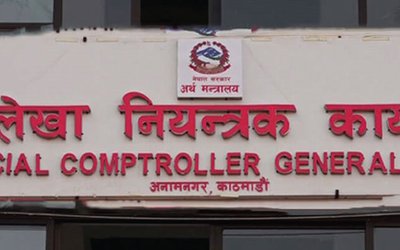Making massive investments in the non-productive sectors, including real estate, housing and hire-purchase over the last six months, Nepal’s commercial banks are now facing a cash crunch and halting their investment in the agricultural and industrial sectors.
With cash flow declining, the commercial banks have already doubled the interest rate on savings. Commercial banks are offering up to 11 percent and development banks are offering up to 13 percent per annum of interest rates on saving accounts.
Despite the increased interest rate, money is not coming back. As the banks tighten the loan, the share market is now heading toward a crash, with the market likely to see further decline.
According to a report, many commercial banks are literally left without any money to extend new loans, showing that the credit expansion of most of these banks will be likely to come to a grinding halt. The banks have been demanding fresh financing facility for the time being to revive their lending capacity.
According to the figures released by Nepal Bankers Association (NBA), the umbrella organization of 28 commercial banks of the country, commercial banks have a combined Rs 41.61 billion left for lending. Out of this, Rastriya Banijya Bank Ltd (RBBL) -- a government-owned bank -- holds Rs 24.78 billion, while the remaining 27 commercial banks have only Rs 16.83 billion, which can be used for credit purpose. Excluding RBBL, a commercial bank has an average of Rs 620 million at its disposal for lending.
"As this scarce fund should be used for disbursement to borrowers to whom the bank has already pledged, there is no way we can provide loans to new borrowers and projects,” said Anil K Shah, president of NBA.
The liquidity, or loanable fund, crunch is attributed to the sudden surge in the lending despite slowdown in deposit mobilization. Deposits have slowed in recent months due to deceleration in remittance growth as well as the failure of the government to increase development expenditure, while banks have been on a lending spree amid rising credit demands and pressure to expand business with the rise in their paid-up capital.
Had this surplus fund, which is lying idle with the government, been spent as planned, it would have pumped money into the banking system. Bank deposits depleted further, when taxpayers withdrew nearly Rs 40 billion from the banking system to file taxes at the second quarter-end.
Bankers say that the central bank should immediately intervene to insulate the economy from the effect of the liquidity crunch. Either the government should expedite capital spending, which will pump money into the banking system, or the NRB should inject money in the banking system, which banks can use as fund for lending against the government securities they hold, according to bankers.
"Bankers are demanding revision of credit to core-capital-cum-deposit (CCD) ratio to make it 85 percent or scrap altogether. This will likely help to free up additional funds in the banking system," said Shah, CEO of Mega Bank Ltd.
“The tightening of the CCD ratio -- a rule enforced by the NRB to measure liquidity ratio of the BFIs -- has crippled the capacity of the banks to extend lending,” said Shah.
According to present regulations, a bank must have 80 percent of CCD, the average CCD ratio stands at 78 percent, meaning they have only 2 percentage point capacity to lend from the deposits and core capital that they hold.
NRB seems reluctant to intervene immediately, leaving banks to resolve the problem on their own. "This is the problem created by banks themselves through haphazard and aggressive lending without making prudent assessment while floating loans," Narayan Prasad Paudel, an executive director of NRB, said. “Banks should offer higher interest rates on saving deposits to attract more funds and retain the deposits that are maturing."
"Scrapping or relaxing a particular rule to address some problem is against prudential banking norms and practices and financial stability," said Paudel.
Some commercial banks have been offering interest rates of as high as 12 percent on fixed deposit schemes, they are failing to compete with development banks, financial institutions, which are giving higher interest rates. As development banks, financial institutions and cooperatives are giving high interest rates, there has not been much growth on the deposit base of the commercial banks.
NRB blames all this for haphazard lending by commercial banks and argues that the banks should pay higher interest rates to lure the deposit.
With declining flow of remittances, slow growth of capital expenditure and bank’s capital in the unproductive sector, ease in liquidity shortage is unlikely, and this can cripple the economic activities.
- TANAHU HYDROPOWER PROEJCT: A Significant Achievement
- Apr 15, 2024
- AMBASSADOR HANAN GODAR: Sharing Pain With A Nepali Family
- Mar 30, 2024
- VISIT OF KfW AND EIB TO NEPAL : Mission Matters
- Mar 25, 2024
- NEPAL BRITAIN SOCIETY: Pratima Pande's Leadership
- Mar 24, 2024
- NEPAL ARMY DAY: Time To Recall Glory
- Mar 15, 2024
















